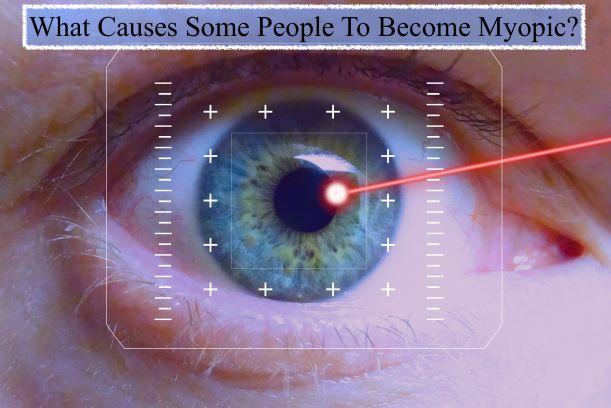What Causes Some People To Become Myopic?

Nearsighted vision, which is technically called myopic eyesight, is a condition that plagues millions of people. In fact, estimates suggest that one-third of the world's population will be nearsighted by the end of the decade.
If you are short-sighted read on to learn what causes this condition and what your treatment options are.
What is Myopic Eyesight?
Myopia, also known as nearsightedness, is a vision condition that makes objects far away seem blurry. People who have myopic eyesight may have trouble seeing road signs, a TV screen or a blackboard at the front of a room.
When someone is short-sighted they have no trouble seeing items up close like the text in a book or details of a carpet for example.
Myopia affects almost 30% of people in the United States.
Causes of Nearsightedness
There can be two causes for myopia. One is if a person's eyeball is too long. That makes light entering in unfocused.
The second cause is if the cornea (or curved front cover of the eye) is too curved. When either of these factors occurs, light is focused in front of your retina instead of directly on it, resulting in the blurriness of distant objects.
Part of the cause of nearsightedness is a person's genetics. If one or both parents are nearsighted, there is a higher chance that their children will be nearsighted. Usually, myopia develops in school-aged children.
Yet, the development of myopic eyesight is affected by how someone uses his or her eyes. People who spend a long time reading, looking at close objects like needlepoint or working at a computer are more likely to develop myopia.
Also, health conditions like diabetes can cause adults to develop myopia. In these cases, symptoms of myopia may also be a sign of variations in blood sugar levels or might be a sign of developing a cataract.
Night Myopia and False Myopia
Some people only experience blurry vision at night. This is called night myopia. It happens when low light and pupil dilation results in unfocused light rays in the eye.
Also, there is something called pseudo or false myopia. It is present in those who do extensive near-vision work. Overusing your eyes can cause far away objects to become blurry after long periods of near work.
Usually, after resting the eyes for a while, the blurry vision will become clear. Keep in mind that continued visual stress can cause a permanent deficiency in distance vision.
You should take frequent rests when working with up-close objects to protect your eyes.
So how do you know which type of myopia you have? An optometrist can determine the cause of your vision problems through an eye exam.
Treatment for Nearsighted Vision
People who are nearsighted can choose one of the various options to help them enjoy distance vision.
Here are the main ways to treat nearsighted vision.
Prescription Glasses
Many people choose to wear eyeglasses to correct their vision problems. Each person's amount of myopia will be different. Depending on the severity of the condition, an individual might only have to wear glasses for certain activities like watching TV, driving a car or going to the movies.
People who are very nearsighted may need to wear prescription glasses all day.
If myopia is your only vision problem, you'll need a single-vision lens. On the other hand, if you are over 40 years old or have myopia due to near-vision work, you might need bifocal or progressive addition lens. These lenses will let you see both in the distance as well as up close.
The downside to glasses is that they can become lost or damaged. Plus, there is an edge to your field of vision.
Contact Lenses
Contact lenses are another option for clear vision. These have the benefit of being invisible. They also don't have an edge or nose or earpieces that could be uncomfortable for some people.
Yet, because they are worn directly on the eyes, proper care is vital to keep your eyes healthy.
Ortho-k or CRT
Another option is orthokeratology, also known as corneal refractive therapy.
This is a non-surgical procedure that uses special rigid contact lenses to slowly reshape the curvature of your cornea. Usually, these lenses are worn overnight for a period of time.
The rigid lenses place pressure on the cornea which changes the way light is focused in the eye.
This method works for those with mild myopia.
Laser Procedures
Laser procedures can treat myopic vision in adults. These procedures such as advanced lasik eye surgery use a laser beam of light to reshape the cornea by removing a small amount of eye tissue.
Laser procedures can safely remove a limited amount of corneal tissue.
There are two main kinds of laser procedures to repair myopia. Lasik eye surgery involves removing tissue from the inner layers of the cornea. The precise amount removed depends on your vision. Then, the flap of the outer tissue is put back in place to heal.
In PRK, a laser removes a thin layer from the surface of the cornea to change the shape.
For both procedures, downtime is minimal. Your eyes start to heal right away and as they continue healing, your eyesight continues to improve.
Bottom Line
Thanks for reading. We hope you found this article helpful. Now you know the causes of myopia and the various myopic treatments for you to consider.
Come back again soon for more health, fitness, and healthy lifestyle content for you to read.
Previous Posts: